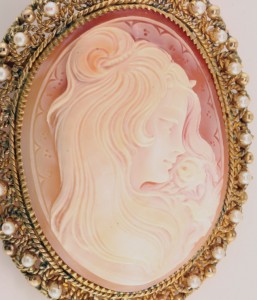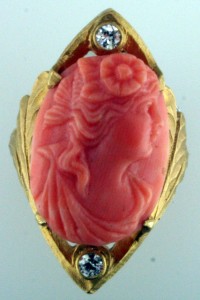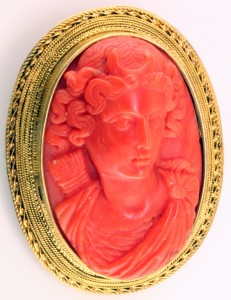How to Judge the Quality of Cameos and Intaglios
December 5th, 2008 by James L. Sweaney, CGA, FGA. GGCameos are carvings of gem materials in which the subject carved is in positive relief from the base of the cameo, as opposed to Intaglios, where the subject is carved negatively (into the surface of the gem material). Cameos are more often seen in jewelry objects where the beauty of the piece is foremost, the carved subject being much more visual and accessible. Intaglios are more utilitarian, most often seen in “signet” type rings where the carving would be only be shown in relief after being impressed into sealing wax or similar materials.
The most common cameo materials in today’s world are natural shell with contrasting color layers, a relatively soft material derived from large sea “snails” such as the helmet shell and related species; and layered agate, a much harder stone comprised of cryptocrystalline quartz which has contrasting color layers (usually dyed to enhance the color contrast of the layers). Precious corals and other softer ornamental materials have also been used for the artist’s palette. Cameos (and Intaglios) carved from agate and similar materials are commonly categorized as “hardstone” as opposed to the softer shell and coral pieces. Inexpensive intaglios are cut from hematite, sometimes referred to as “Black Diamond” for its high luster. For the most part, the materials used for cameos and intaglios are chosen for beauty and suitability rather than value.
Layered types of shell have been used commonly since the mid 18th century, although some examples date to the Renaissance. A carving industry developed in the Italian seaside village of Torre del Greco near Naples, which remains the center for shell cameo carvings.
My number one tip for judging cameos is to look at the quality of the carving. By quality of the carving, I mean three things.
First, the actual carving itself should be detailed, refined and lifelike. Photo #1 shows a large shell cameo, with a common subject, a portrait of a lady. Careful examination show that while the composition of the piece may be pleasing, the execution is rather flat. Sharp edges define the face, where a more refined carving would show softer more realistic depiction. The strokes that frame and define the border are workmanlike rather than beautiful. Overall, I would rate this carving quality as a “journeyman” rather than “master.”
Compare this Art Nouveau coral cameo ring and the “Wonder Woman” coral brooch. In the ring, the carving is softer and more fluid. The carving begins to have real personality.
“Wonder Woman” is even better with more detail, and a much more difficult presentation of the subject—full-face portraits are always much more difficult than silhouettes. Here, Diana truly has presence—you can imagine what Actaeon must have felt as he looked into those piercing eyes, just before she transformed him into a stag and set the hounds on him.
One indicator of a quality carving is the presence of a signature. Master carvers in some studios sign their work, a privilege not accorded to journeymen or apprentices, however, not all masterworks are signed.
Which brings me to the second aspect denoting quality—quality of material. Carving skills develop over years of practice, so naturally in the carving room, the most accomplished carvers are given the best material.
Shell that has the most contrast between color layers will make the most dramatic cameo. Premium pieces will generally have an even, slightly domed surface, although a master might choose a piece with a more uneven or rolling surface because it could suit a more challenging composition.
In the case of coral, the carver can stretch his skills because the coral pieces have more thickness. Wonder Woman literally leaps out of the material. Here, the choice pieces will usually have vivid, even coloration with even grain and no blemishes or bore holes. A master carver may choose a more unusual piece just to show off his skills.
Finally, I look at the overall effect of the composition. Is it interesting? Is it unusual? Does it tell a story? #1 is a wistful but sentimental portrait, #2 is more dramatic, but #3 is just fascinating.
A word about hardstone cameos—the skills required to skillfully execute great cameo and intaglio carvings in agate are hard won over years and years of work. Not many artists in today’s hurry-up world have the tenacity and opportunity to develop these skills because of the economics of the global marketplace, where cheap labor is king.
While the master is often hand carved by a skilled cameo artist, most of the hardstone cameos are now mass-produced with ultrasonic milling machines. The composition of such pieces can be beautiful, but of course without individuality.
A small market exists for the individual one-of-a-kind hardstone cameo, usually portraiture. There are very few people working in this field, as this is one of the hardest challenges for any gemstone carver. The combination of a highly developed artistic ability, craft skill and many years of experience are needed to be able to create life-like portraits.










